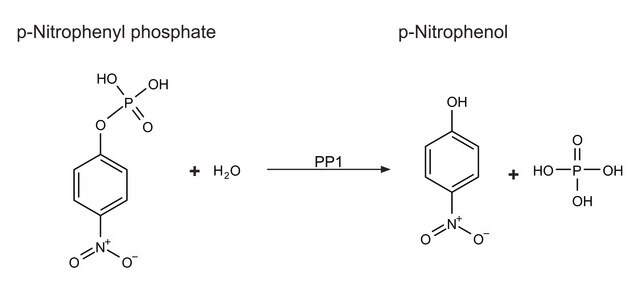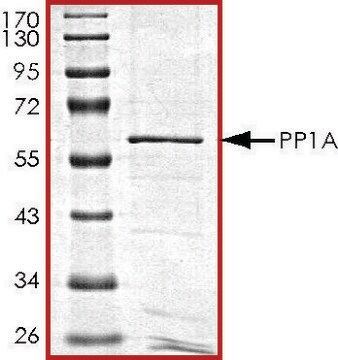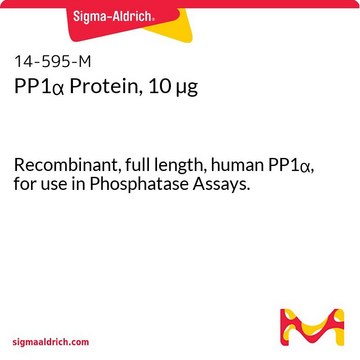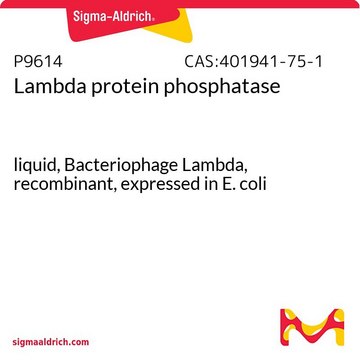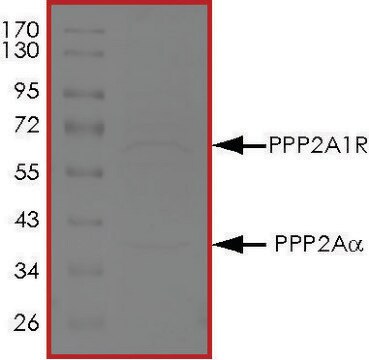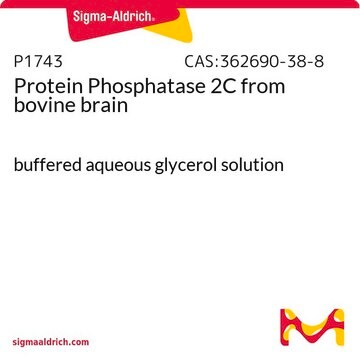P6993
Protein Phosphatase 2A1 bovine
≥1500 units/mg protein
Synonym(s):
PPA2A1
Sign Into View Organizational & Contract Pricing
All Photos(1)
About This Item
Recommended Products
biological source
bovine
Quality Level
Assay
≥90% (SDS-PAGE)
form
solution
specific activity
≥1500 units/mg protein
mol wt
192 kDa
packaging
vial of 1 μg
shipped in
dry ice
storage temp.
−70°C
General description
Protein Phosphatase 2A1 (PP2A1) belongs to the PP2A family and comprises trimeric A, B and C subunits. PPA2 enzymes are serine/threonine phosphatases and exist as several isoforms.
Application
Protein phosphatase 2A1 has been used to treat human fibroblast cells prior to western blot analysis.
Biochem/physiol Actions
Protein Phosphatase 2A is a cytoplasmic protein, which colocalizes with microtubule proteins and is involved in the dephosphorylation of the tau protein and oncoprotein 18. Protein Phosphatase 2A1 (PP2A1) binds to polymerized microtubule proteins and may be targeted by tubulin in modulating phosphatase activity. PP2A1 is implicated as a growth suppressor and is associated with dysregulation in cancer. It also regulates cell cycle, RNA splicing differentiation, and signal transduction. PP2A dysfunction is correlated to the tau protein deregulation in Alzheimer′s disease pathophysiology. Protein Phosphatase 2A1 is a divalent cation-dependent protein serine/threonine phosphatase implicated as a growth suppressor and is associated with dysregulation in cancer.
Unit Definition
One unit will release 1.0 nanomole of phosphate from 32P-labeled phosphorylase A per minute at pH 7.0 at 30 °C.
Physical form
Solution in 50 mM Tris-HCl, pH 7.0, containing 14 mM 2-mercaptoethanol, 1 mM benzamidine, 0.1 mM PMSF, 1 mM EDTA, and 50% glycerol
Signal Word
Warning
Hazard Statements
Precautionary Statements
Hazard Classifications
Skin Sens. 1
Storage Class Code
10 - Combustible liquids
WGK
WGK 2
Flash Point(F)
Not applicable
Flash Point(C)
Not applicable
Choose from one of the most recent versions:
Already Own This Product?
Find documentation for the products that you have recently purchased in the Document Library.
K Webley et al.
Molecular and cellular biology, 20(8), 2803-2808 (2000-03-25)
Replicative senescence in human fibroblasts is absolutely dependent on the function of the phosphoprotein p53 and correlates with activation of p53-dependent transcription. However, no evidence for posttranslational modification of p53 in senescence has been presented, raising the possibility that changes
A Hiraga et al.
The Biochemical journal, 346 Pt 2, 433-439 (2000-03-24)
Protein phosphatase (PP) 2A1, a trimer composed of A-, B- and C-subunits in the PP2A family, has been regarded as a principal form localizing at microtubules (MT), but PP2A2, the dimer of A- and C-subunits, has not. Substantiating the claim
Our team of scientists has experience in all areas of research including Life Science, Material Science, Chemical Synthesis, Chromatography, Analytical and many others.
Contact Technical Service
